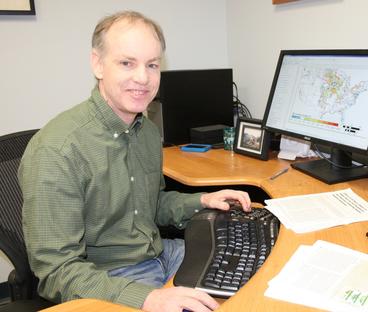Did you know that Minnesota’s public schools are partially funded by revenue from state lands? Get out your No. 2 pencils for a mini history lesson.
In 1858, the federal government granted land to Minnesota "for the use of schools" which is managed by the Department of Natural Resources. It was written into the state Constitution.
The revenue from School Trust Lands – 2.5 million acres – is generated from mineral leases, timber sales and other real estate transactions. But what if the lands could make money by managing the forests for timber and carbon storage simultaneously?
The rise of carbon markets is making that a possibility. It’s a way to compensate landowners for their stewardship, which benefits everyone. NRRI Landscape Ecologist Christopher Wright is working to understand the possibilities and opportunities for carbon sequestration on Minnesota’s School Trust Lands.
Carbon markets 101
Carbon markets aim to reduce carbon emissions with a “cap-and-trade” mechanism. Governments cap how much carbon an industry or business can emit. If it emits beyond its cap, it must trade for carbon credits earned elsewhere for carbon emission reductions. It’s similar to the Wetland Bank Credits system set up in Minnesota in 1994 to keep wetlands on the landscape.
California is the U.S. leader in raising money through carbon markets. But Minnesota is catching up.
“Forests everywhere capture and store carbon and also release oxygen, so they’re very beneficial to humans,” said John DuPlissis, NRRI Forestry Program manager. “Active management of School Trust lands can improve carbon sequestration potential as well as carbon stored in long-lived forest products.”
Minnesota’s forests store the equivalent of 50 years of all carbon dioxide emissions produced in the state, and about 75 tons of carbon per acre, according to the Forest Resources Association’s Minnesota Carbon Fact sheet.
And while carbon storage is vitally important, active management can improve other ‘ecosystem services’ that forests provide to society, including water-quality protection and wildlife habitat.
The Office of School Trust Lands has a fiduciary responsibility to manage forests for long-term returns, which goes hand-in-hand with an environmental responsibility.

“This gives them the flexibility to pursue economic returns from multiple ecosystem services markets – including timber, carbon sequestration, water-quality enhancement, and wildlife habitat,” explained Wright. “This is a new and exciting direction for School Trust Lands in Minnesota and nationwide. Carbon-centric forest management has likely benefits for water quality and wildlife.”
Moving Forward
Wright just published a white paper outlining the markets, opportunities and challenges. It’s titled Improved Forest Management: An Opportunity to Stack Multiple Ecosystem on School Trust Lands
The paper will be distributed by Dovetail Partners, a non-profit that provides information about the impacts and trade-offs of environmental management, including consumption choices, land use decisions and policy alternatives.
Wright hopes the white paper helps move the conversation forward and sets policy in motion to make Minnesota a leader in not only carbon sequestration, but in marketing multiple ecosystem services. Among Wright’s recommendations for the School Trust Lands, he cites:
- Conducting a comprehensive inventory of School Trust lands to identify the best and most marketable opportunities for ecosystem services.
- Adopting a consistent set of criteria for wetland mitigation, endangered species mitigation, and carbon market transactions to guide identification of lands for ecosystem services projects.
- Using ecosystem service criteria to conduct a strategic assessment of State Trust lands.
“Mining and timber, are an important way to monetize our natural resources,” Wright said. “But especially now, as we experience the impacts of climate change, we have an opportunity to obtain value from other services we get from our forest landscapes.”
This project was made possible through the support of the Doris Duke Charitable Foundation and The Nature Conservancy’s Natural Climate Solutions Accelerator program. Project partners include Dovetail Partners, the Minnesota Department of Natural Resources Resource Assessment Program, NRRI, the Minnesota Office of School Trust Lands and The Nature Conservancy.
